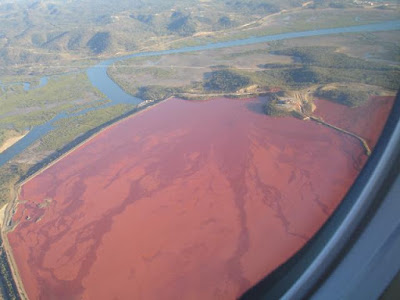Synthesis of Polymer-Coated Magnetic Nanoparticles from Red Mud Waste for Enhanced Oil Recovery in Offshore Reservoirs
http://repository.vnu.edu.vn/handle/VNU_123/27393
Buried red mud waste from groundwater refineries can cause pollution.
The aim of this paper is to utilize this mud for the synthesis of Fe3O4magnetic nanoparticles (MNPs). Then, MNPs are encapsulated by a copolymer of me-thyl methacrylate and 2-acrylamido-2-methyl-1-propanesulfonate via oleic acid linker.
MNPs are prepared by a controlled co-precipitation method in the presence of a dispersant and surface-modified agents to achieve a high hydrophobic or hydrophilic surface.
Mini-emulsion polymerization was con-ducted to construct a core–shell structure with MNPs as core and the copolymer as shell.
The core–shell structure of the obtained particles enables them to disperse well in brine and to stabilize at high-temperature environ-ments.
The chemical structures and morphology of this nanocomposite were investigated by Fourier transform infrared spectroscopy, transmission elec-tron microscopy, and field emission scanning electron microscopy.
The ther-mal stability of the nanocomposite was evaluated via a thermogravimetric analysis method for the solid state and an annealing experiment for the liquid state.
The nanocomposite is about 14 nm, disperses well in brine and is thermally stable in the solid state.
The blends of synthesized nanocomposite and carboxylate surfactant effectively reduced the interfacial tension between crude oil and brine, and remained thermally stable after 31 days annealed at 100 C. Therefore, a nanofluid of copolymer/magnetic nanocomposite can be applied as an enhanced oil recovery agent for harsh environments in offshore reservoirs.
Buried red mud waste from groundwater refineries can cause pollution.
The aim of this paper is to utilize this mud for the synthesis of Fe3O4magnetic nanoparticles (MNPs). Then, MNPs are encapsulated by a copolymer of me-thyl methacrylate and 2-acrylamido-2-methyl-1-propanesulfonate via oleic acid linker.
MNPs are prepared by a controlled co-precipitation method in the presence of a dispersant and surface-modified agents to achieve a high hydrophobic or hydrophilic surface.
Mini-emulsion polymerization was con-ducted to construct a core–shell structure with MNPs as core and the copolymer as shell.
The core–shell structure of the obtained particles enables them to disperse well in brine and to stabilize at high-temperature environ-ments.
The chemical structures and morphology of this nanocomposite were investigated by Fourier transform infrared spectroscopy, transmission elec-tron microscopy, and field emission scanning electron microscopy.
The ther-mal stability of the nanocomposite was evaluated via a thermogravimetric analysis method for the solid state and an annealing experiment for the liquid state.
The nanocomposite is about 14 nm, disperses well in brine and is thermally stable in the solid state.
The blends of synthesized nanocomposite and carboxylate surfactant effectively reduced the interfacial tension between crude oil and brine, and remained thermally stable after 31 days annealed at 100 C. Therefore, a nanofluid of copolymer/magnetic nanocomposite can be applied as an enhanced oil recovery agent for harsh environments in offshore reservoirs.
| Title: | Synthesis of Polymer-Coated Magnetic Nanoparticles from Red Mud Waste for Enhanced Oil Recovery in Offshore Reservoirs |
| Authors: | Nguyen, T. P. Le, U. T. P. Ngo, K. T. |
| Keywords: | Red mud waste Offshore Enhanced oil recovery Core–shell Magnetic nanoparticles Mini-emulsion polymerization |
| Issue Date: | 2016 |
| Publisher: | H. : Đại học Quốc gia Hà Nội |
| Citation: | ISIKNOWLEDGE |
| Abstract: | Buried red mud waste from groundwater refineries can cause pollution. The aim of this paper is to utilize this mud for the synthesis of Fe3O4magnetic nanoparticles (MNPs). Then, MNPs are encapsulated by a copolymer of me-thyl methacrylate and 2-acrylamido-2-methyl-1-propanesulfonate via oleic acid linker. MNPs are prepared by a controlled co-precipitation method in the presence of a dispersant and surface-modified agents to achieve a high hydrophobic or hydrophilic surface. Mini-emulsion polymerization was con-ducted to construct a core–shell structure with MNPs as core and the copolymer as shell. The core–shell structure of the obtained particles enables them to disperse well in brine and to stabilize at high-temperature environ-ments. The chemical structures and morphology of this nanocomposite were investigated by Fourier transform infrared spectroscopy, transmission elec-tron microscopy, and field emission scanning electron microscopy. The ther-mal stability of the nanocomposite was evaluated via a thermogravimetric analysis method for the solid state and an annealing experiment for the liquid state. The nanocomposite is about 14 nm, disperses well in brine and is thermally stable in the solid state. The blends of synthesized nanocomposite and carboxylate surfactant effectively reduced the interfacial tension between crude oil and brine, and remained thermally stable after 31 days annealed at 100 C. Therefore, a nanofluid of copolymer/magnetic nanocomposite can be applied as an enhanced oil recovery agent for harsh environments in offshore reservoirs. |
| Description: | JOURNAL OF ELECTRONIC MATERIALS Volume: 45 Issue: 7 Pages: 3801-3808 ; TNS06425 |
| URI: | http://repository.vnu.edu.vn/handle/VNU_123/27393 |
| Appears in Collections: | Bài báo của ĐHQGHN trong Web of Science |


Nhận xét
Đăng nhận xét